Famous for its white houses and beautiful blue-domed churches is the small but stunning island of Santorini, Greece – the volcanic gem of the Aegean Sea. While everyone knows what the island is famous for, there are certain things to know before going to Santorini.
Santorini forms the southernmost point of the famous Cyclades island group. And whilst the picture-perfect skyline of Oía is probably what the island is known for around the world, the famous town is overrun with tourists, and sadly anything from scenic.
It can be hard to find out how to have a good experience without all the tourists in Santorini, but with the right information, you’ll discover it does have so much more to offer.
Affiliate Link Disclosure: This post contains affiliate links. If you use them to make a purchase, we may earn a small commission at no extra cost to you. As an Amazon Associate, we earn from qualifying purchases. Learn more in our Affiliate Link Disclosure.
Things to Know About Santorini

I want to help you make the most of your visit to Santorini, which many people consider one of the most beautiful Greek islands (despite how touristy it is) so you can have an authentic and meaningful experience far away from tourist crowds.
Here are 12 things you need to know before going to Santorini, so your holiday there will be amazing!
1. An Overview of Santorini’s History
Only a few people know that these days Santorini looks very different to how it used to. So, it can’t hurt to have a little knowledge about Santorini’s explosive history.
The island’s great beauty is a result of several volcanic eruptions over many years. Nowadays you can find craters of the volcano on two small separate islands, Palea Kameni and Nea Kameni (the volcano).
The craters can be visited on a boat trip and are famous for their hot springs.
The volcano is still considered active and is being monitored closely by authorities to determine whether it poses any danger to Santorini’s population. The last eruption happened in 1950, but people are still very much aware of the threat.
From the colour of the beaches (red and black volcanic pebble beaches) to the salty taste of the wine and the tomatoes, the volcano has had an impact on many things. The water around the volcano is also known for its therapeutic effects.
The locals of Santorini live scattered all across the island. Nestled between hundreds and hundreds of hotels you can usually find them in small traditional cave houses.
While most modern buildings on the island are not dug into the stone, a lot of locals use the massive stone cliffs to dig their houses into, to avoid damage from the frequent earthquakes.
The cave houses are not only amazing at protecting the people from earthquakes, but they also protect them from the heat and the wind on the island.
2. How to Get to Santorini
It is quite easy to get to Santorini! Although it does depend on where you come from and what your budget is. The level of comfort you wish to have also determines how you’ll get to Santorini.
Here are the three options on how to go to Santorini:
By Plane: Santorini has an international airport, Santorini (Thira) National Airport (JTR). The small airport receives flights from many major cities in Europe and other parts of the world. If you come from the US, you might have to fly to Athens first.
By Ferry: If you are already in Greece or any of the nearby islands (such as Milos, which is recommended for its beaches) you can take a ferry to Santorini. Ferries operate from many ports in Greece, the most common ones are Athens, Mykonos and Crete.
The duration of the ferry trip depends on your departure point. For example, a ferry from Athens (Piraeus) typically takes about 5-8 hours. It can be slightly uncomfortable to go with the ferry, especially if you get seasick easily. My preferred option is to fly for that reason.
By Cruise Ship: Santorini is a popular destination for cruise ships in the Eastern Mediterranean. If you are on a cruise, check if Santorini is included in your itinerary. That is usually the case on cruises in that area.
Cruise ships usually anchor off the coast, and passengers are transported to the island by tender boats.
The downside of coming by cruise ship is, that you will only have one day on the island.
Make sure to check the schedules and availability of flights and ferries, and cruise ship itineraries in advance. Especially during peak travel seasons, as it can get very busy. Try to make necessary reservations in advance, to ensure a smooth, stress-free journey to Santorini.
3. How to Get Around Santorini
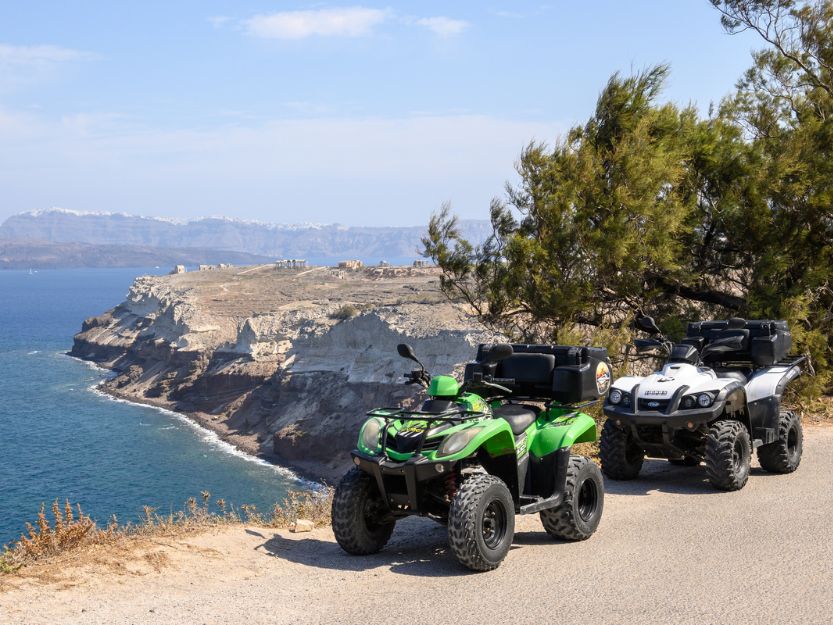
From the airport or the ferry port, you can use taxis or pre-arranged transfers to reach your accommodation. There are also local buses available, however, I do not recommend them. I suggest pre-booking your transfer because there are not that many taxis available.
If you plan to explore the island independently, you can rent a scooter or an ATV. This is a cheap, fun and easy way to get around the island and explore off the beaten track. It is definitely one of our preferred ways to get around Santorini, the only thing is that they can’t carry any luggage, so I suggest not using them straight from the airport.
You could also book a guided small group ATV tour if that’s more to your taste.
A rental car is also a good option to get around on the island. However, it can be hard to find parking spaces. Plus, some of the small and winding streets are pretty tricky to drive on, and pranging your rental car is a real risk – trust me, we’ve done it!
4. Off the Beaten Track Places to Eat in Santorini
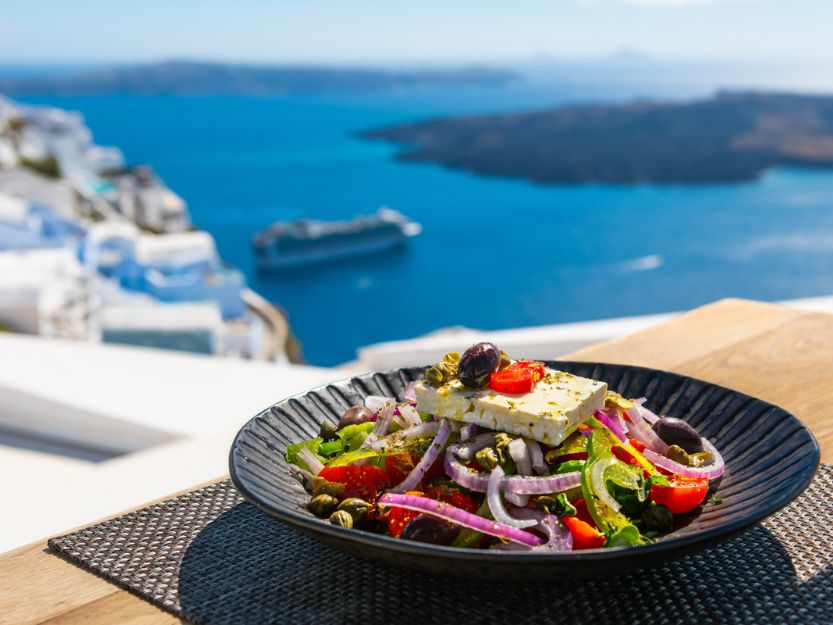
There are a huge amount of different restaurants in Santorini. From traditional Greek cuisine to fine dining – there is something for every taste.
Sadly, many restaurants in Oia are ridiculously overpriced and not worth the money. You pay more (much more) for the location than for the quality of the food.
Luckily, there are many other great options to eat outside of Oia. Eating off-the-beaten-track in Santorini is the best way to ensure that you get your money’s worth in food. The traditional Greek tavernas on the island have an excellent reputation.
Our favourite place to eat in Santorini is Pyrgos and the area around the village. There are many amazing restaurants with a view that serve delicious food. The possibilities for restaurants in Pyrgos are endless.
Equally cute and quiet is the village of Megalochori. Make sure to check out the little restaurants nestled around the town square (if you can call it that) as they are not overly touristic yet.
If you still feel like having a meal or two in Oia, try going for breakfast or lunch. This way you can avoid the crowds at least a little bit.
5. Where Not to Stay in Santorini
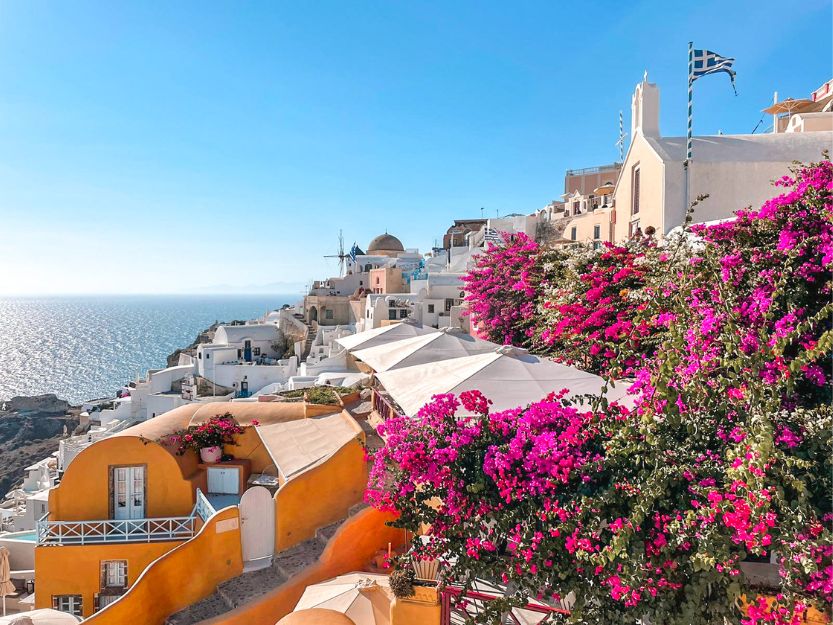
The most famous Airbnbs, Vrbos and hotels with stunning views are most likely to be found in Oia. However, I do not recommend booking one of these places. Firstly, you are overpaying tenfold just because the accommodations are closer to the famous Instagram spots.
Secondly, most of these places are hardly private. Having wandered through the streets of Oia, I noticed that most of the “private” balconies and terraces are right next to the footpath. You will sit in your infinity pool right above or below hundreds of tourists.
Truly secluded places in Oia are very hard to come by. And are only being offered for a very steep price. On our recent stays in Santorini, we have looked around for other options to stay in and we have never been disappointed.
You can still drive to Oia to have a look around, but it is not the best place to stay in Santorini. This is one of the most important things you need to know about Santorini.
6. Where to Stay in Santorini
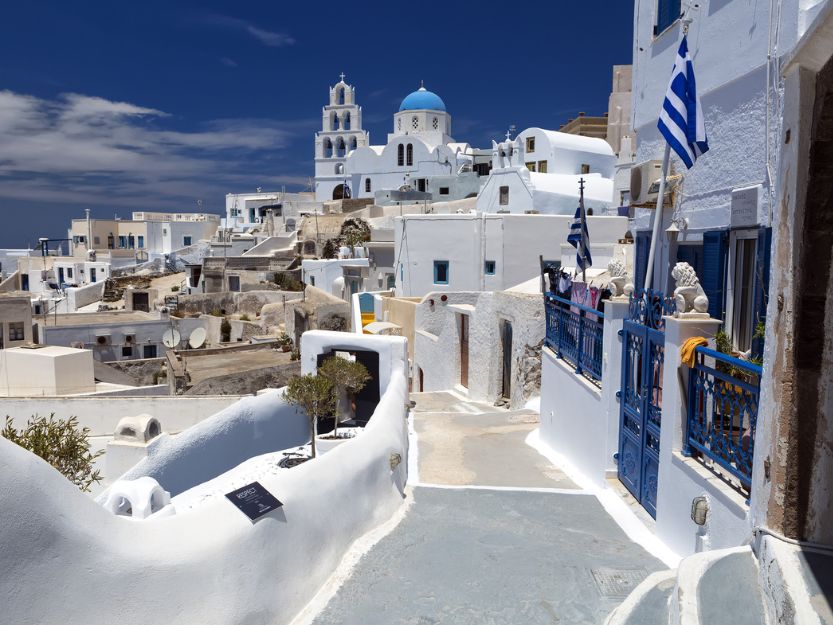
Our favourite villages to stay in on Santorini are Pyrgos, Megalochori or Kamari. Each of the villages has a special charm and are much quieter and also cheaper than the famous towns on the cliff.
In Pyrgos and Megalochori there’s a good chance that your accommodation will have an amazing sunset view over the caldera as well.
Kamari is a bit more vibrant and located on the other side of the island, which means you’re unlikely to have an amazing sunset view. However, it is nestled right alongside a beautiful black sand beach, which I think makes up for the lack of a sunset view.
If you really want to stay on the cliffside near Oia, try booking accommodation in Imerovigli or Firostefani instead. Both villages are very similar to Oia.
They are a bit more expensive than Pyrgos, Megalochori, and Kamari, but still not as overpriced as Oia.
BOOK SANTORINI ACCOMMODATION HERE
7. Best Beaches in Santorini
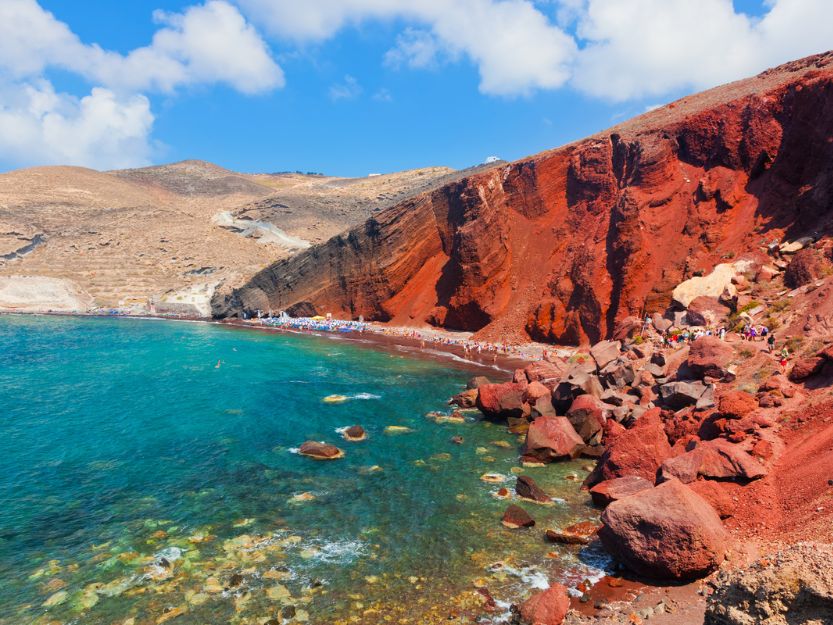
While Santorini is not known as a prime destination for a beach holiday, there are some things you need to know about Santorini beaches before you go, including that some are best accessed by boat.
Santorini beaches are slightly different to those on other Greek islands. So, here is a rundown of the most interesting beaches in Santorini:
- Perissa Beach is located on the southeastern coast. Perissa Beach is known for its black volcanic sand. It has a great atmosphere, a couple of beach bars, and you can do water sports activities. A great spot for a relaxed day on the beach and for families.
- Kamari Beach is located right next to Perissa Beach and also has black sand. There are many sunbeds, umbrellas, restaurants, and beachfront cafes. Walk along the lively boulevard and buy some souvenirs on Kamari Beach.
- Red Beach: One of the most famous beaches in Santorini is Red Beach. Red Beach has impressive red cliffs and a unique volcanic landscape. The beach itself is relatively small but offers stunning views and is a popular spot for snorkelling. It is a bit hard to get there, but worth the travel.
- Vlychada Beach is famous for its peculiar rock formations and lunar-like landscape. It’s a less crowded beach with a more quiet atmosphere.
- White Beach is located close to Red Beach and is known for its cliffs and white pebbles. It is accessible only by boat or by hiking from Red Beach
- Amoudi Bay: Although not a traditional sandy beach, Amoudi Bay is a cute fishing village with crystal-clear waters. It’s a popular spot for swimming, cliff jumping, and enjoying fresh seafood at waterfront tavernas.
8. Best Time to Go to Santorini
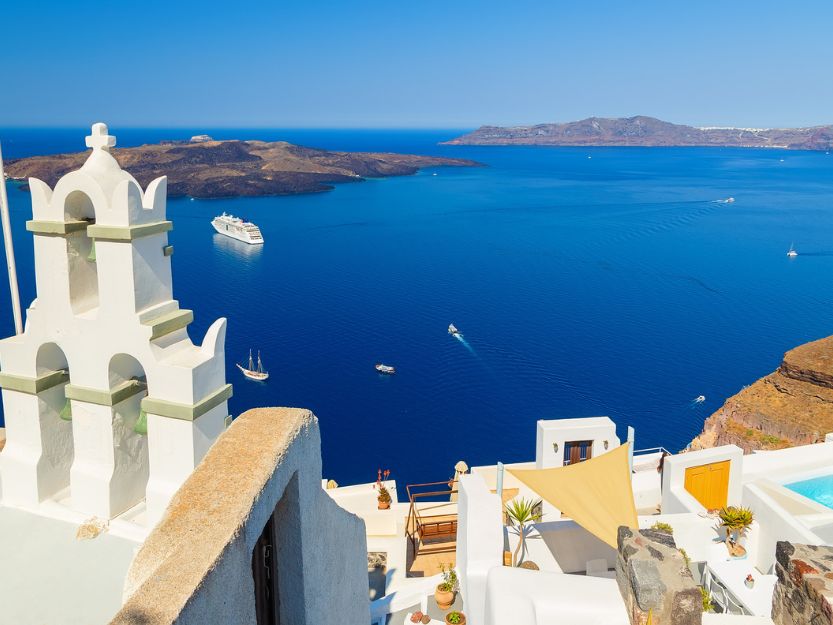
The best time to visit Santorini depends on your preferences and what you plan to do on the island. Of course, it also depends on your budget.
My favourite month to go to Santorini is June, but it might be different for you. Overall, the best time to visit Santorini for most travellers is during the shoulder seasons of Spring (April-May) and Autumn (September-October) when the weather is pleasant. There are fewer crowds compared to the peak summer months, so you actually get to enjoy the island.
June is still a great time to visit, even though the masses of people are slowly increasing. I would not recommend visiting in July or August as it gets extremely busy.
Here’s a quick overview of the weather in Santorini throughout the year:
Spring (April to May): Spring is a great time to visit Santorini, with mild temperatures from 15°C to 23°C (59°F to 73°F). The flowers on the island start to bloom, and it’s less crowded than the peak summer season.
Summer (June to August): Summer is the high season in Santorini. There is plenty of sunshine and the temperatures range from 24°C to 30°C (75°F to 86°F). It’s the busiest time on the island, with large crowds of tourists. The sea is warm and perfect for swimming. Keep in mind that hotel rates are at their highest during this period and the island is completely overrun.
Autumn (September to October): Autumn is another excellent time to visit Santorini. The temperatures are still warm, with 20°C to 26°C (68°F to 79°F). The crowds start to thin out, but the sea remains warm. It’s a great time to enjoy pleasant weather and explore the island without the summer crowds.
Winter (November to March): Winter is the off-peak season in Santorini. The temperatures are ranging from 10°C to 16°C (50°F to 61°F), but it can be cooler and rainier. Many businesses are closed during this time. However, you can experience a quieter side of the island and potentially find better deals on accommodations.
9. How to Have a More Meaningful Travel Experience in Santorini
Despite the masses of tourists that roam Santorini island, peaceful times can be found there. The village of Oía and the capital city Thira are by far the most crowded places on the island. They should be avoided during peak hours (basically all afternoon and during sunset).
A nice stroll around is still possible, especially very early in the morning. If you want to see the beautiful sunset over the white houses I strongly recommend going to Imerovigli or Firostefani instead. They are much quieter, but the view is just as stunning.
Slow travellers might find themselves happier exploring the villages of Pyrgos and Megalochori. Pyrgos is a cute town surrounding Mount Profitis Illias from where you have a great view of the whole island and the sunset without the masses of people.
Choose smaller and more authentic restaurants over the overpriced tourist haunts, you will not regret it. The atmosphere is much more fun, light, and happy – and way less stuffy. Eat local products and try some local wine for an authentic Greek experience.
If you are interested in tours and other activities, try booking experiences with a local guide or in smaller groups. You might pay a bit extra, but it is worth it.
If you are practicing mindful travel don’t plan too much for your time in Santorini. Leave time in your itinerary to just wander and enjoy the beauty of the island.
Lastly, be respectful when taking photos. Many influencers advertise trespassing to get a good shot in Santorini. I think this is extremely rude, please don’t do that to the locals.
10. Is Santorini a Safe Place for Tourists
Generally, the locals were friendly and helpful. We’d assumed that they would be fed up to some degree with all the tourists. But on the contrary, they were lovely and chatty people excited to share insider information about the special island they call home.
The crime rates on the island are relatively low, and violent crimes rarely happen. The main consideration, as for anywhere, should be protecting your belongings. While Santorini is relatively safe, petty theft and pick-pocketing can happen. Keep an eye on your stuff, use hotel safes for valuable items, and be cautious in crowded areas.
Be sure to use licensed taxis or transportation services to avoid scams or being overcharged. If you’re unsure, your hotel staff can help you find good transportation.
11. Is Santorini Expensive?

I would rate Santorini as one of the more expensive European destinations and one of the most expensive Greek islands (along with Mykonos). You can certainly find some great cheaper options for food and accommodation off-the-beaten-track in Greece and across Europe.
Accommodation prices in Santorini can be quite high, especially if you’re looking to stay in the iconic cliffside villages of Oia or Fira. In these places, the demand is particularly high. In my opinion, it is not worth staying there.
Luxury hotels with stunning views of the caldera are particularly expensive. However, there are also more affordable options available in other areas of the island or less touristy villages – like Megalochori.
Dining out in Santorini can also be costly, especially at upscale restaurants with panoramic views. In my opinion, it was not worth the money. Visit local tavernas and nice restaurants outside of Oia instead for a better experience.
Transportation costs, including flights or ferry tickets to reach Santorini, as well as local transportation and tours, can also be quite high and rack up your holiday spending.
Day trips and guided tours also come with a big price tag. But usually, the hosts put in a lot of effort in so it can be worth paying for, I recommend checking the reviews before booking.
12. Our 20 Favourite Things to Do in Santorini
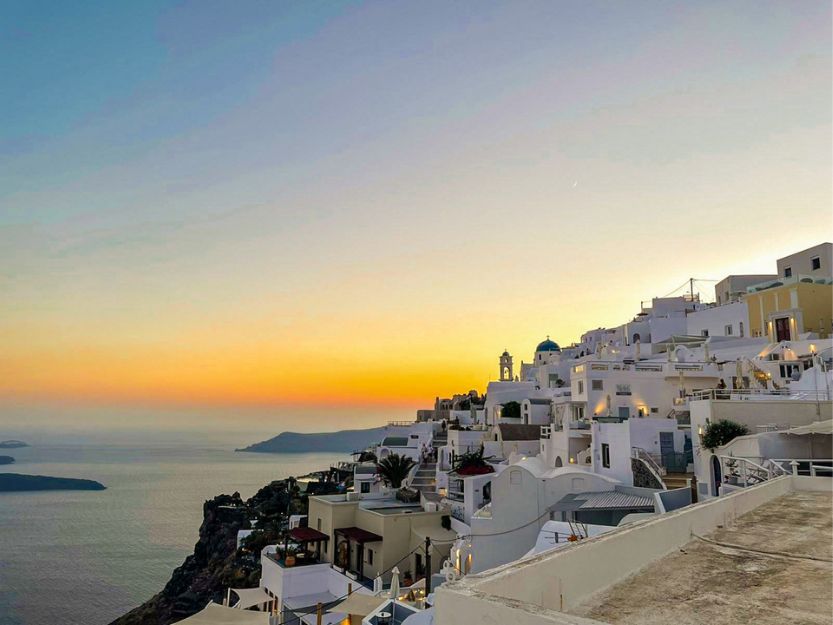
And finally, here are our 20 favourite things you may also like to do in Santorini:
- Visit Mount Profit Ilias and watch the famous Santorini sunset
- Explore the charming village of Fira and have some amazing pancakes at Nektar Lounge
- Take a boat tour to explore the volcano and hot springs and watch the sunset from the catamaran
- Swim and snorkel at the unique Red Beach or the White Beach
- Discover the ancient ruins of Akrotiri, a well-preserved Minoan city
- Take a dip in the natural hot springs at Palea Kameni
- Enjoy a traditional Greek meal at a taverna in Pyrgos (make sure to check out Mythos Tavern)
- Visit the iconic blue-domed churches in Firostefani and Megalochori and take some lovely Instagram pictures
- Hike from Fira to Oia along the breathtaking Caldera cliffs (pack some good shoes and avoid hiking in the sun)
- Explore the picturesque village of Megalochori with its traditional Cycladic architecture and discover some underground caves
- Relax on the black sand beach of Kamari and have some seafood at one of the restaurants on the boulevard
- Visit the wineries and taste the unique volcanic wines of Santorini (make sure to visit Santo Wines Winery for sunset)
- Rent an ATV and drive to the Akrotiri Lighthouse
- Go on a photography tour and capture the island’s stunning views – but make sure to be respectful of the locals
- Explore the hidden gem of Imerovigli and visit Skaros Rock! You can even hike up there if you bring good shoes.
- Take a cooking class and learn how to prepare authentic Greek dishes such as tzatziki! Alternatively, check out a local village with a local guide on a scenic walk.
- Go scuba diving or snorkelling to explore the underwater world of Santorini – Red Beach is the best spot for snorkelling.
- Visit the Museum of Prehistoric Thera in Fira to learn about the island’s ancient history.
- Relax in one of the many fancy spas on the island and be pampered.
- Attend a traditional Greek music and dance performance in one of the island’s tavernas
As you can see a visit to Santorini is worth it, but there are lots of things you need to know before going there. The most important things are to decide where to stay in Santorini and at which time you want to travel there. These two decisions can make all the difference to your trip.
I hope this post gave you a good overview of all the things you need to know about Santorini and will help you have the best time whilst you’re on the island.
Planning Your Trip to Santorini?
Planning your trip to Santorini in Greece? Here are some of our recommended useful resources to help you have the best time possible.
|
● TRAVEL INSURANCE IS AN IMPORTANT CONSIDERATION! World Nomads offers cover for travellers in over 100 countries and True Traveller is a great option if you’re from the UK or EU. SafetyWing is another solution, particularly for digital nomads and long-term travellers. ● Use Wise (formerly Transferwise) for sending or receiving money internationally. It’s cheap, easy and transparent. ● Find amazing flight deals on Skyscanner and Kayak. ● For great prices on ferries check out Ferryhopper. ● Compare charter yacht hire prices on Click&Boat. ● Compare rental car prices on Rentalcars.com. ● You can book train, bus and other ground transportation with Trainline, 12Go and Bookaway. ● Booking.com and Expedia usually have the best hotel prices. ● Our go-to for self-catering accommodation is Vrbo. ● Discover fantastic trips and activities with Viator and GetYourGuide. ● Check out Bookmundi, G Adventures, and Intrepid Travel for group holidays and tours. |
Like this post? Pin it for later!
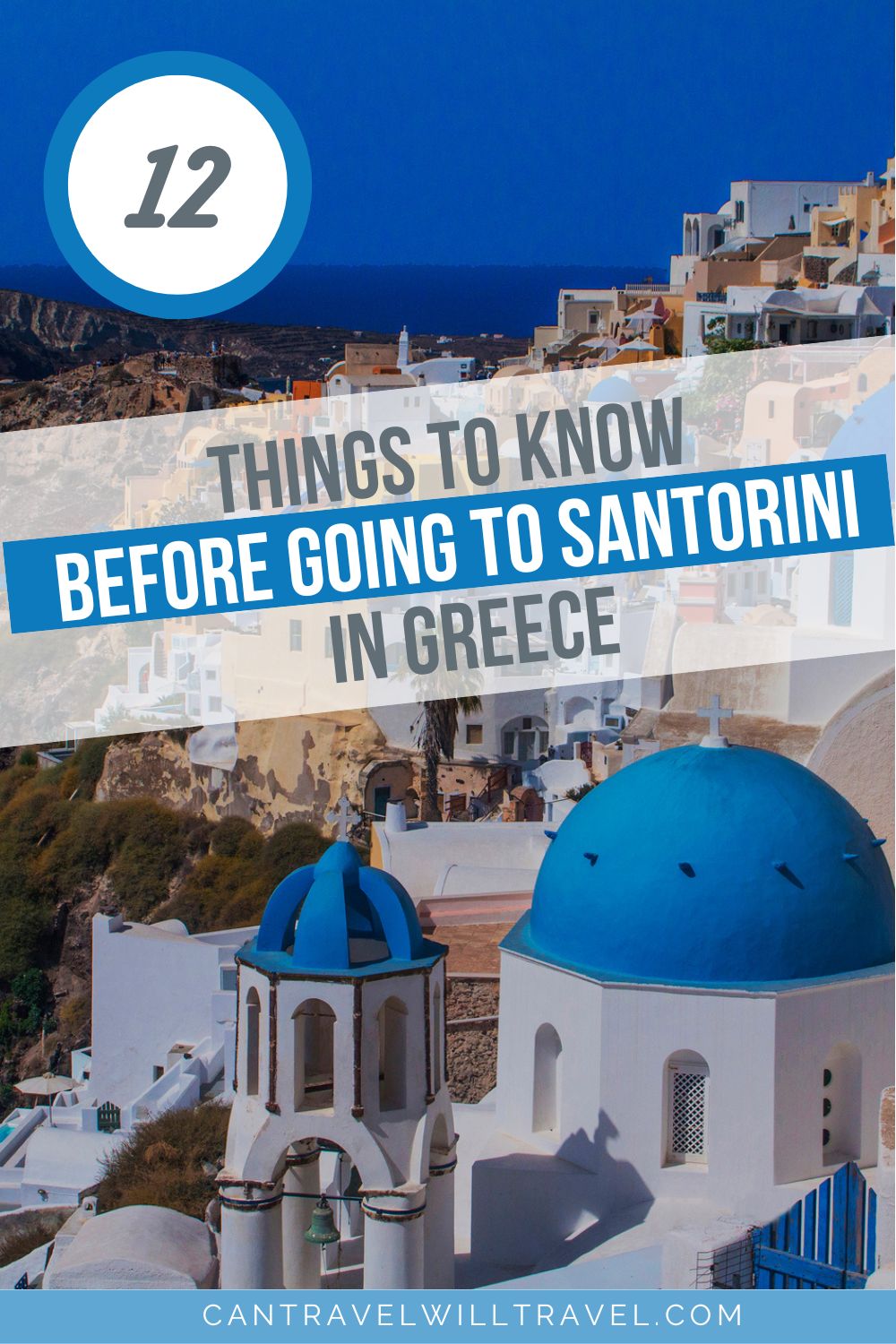 |  |
